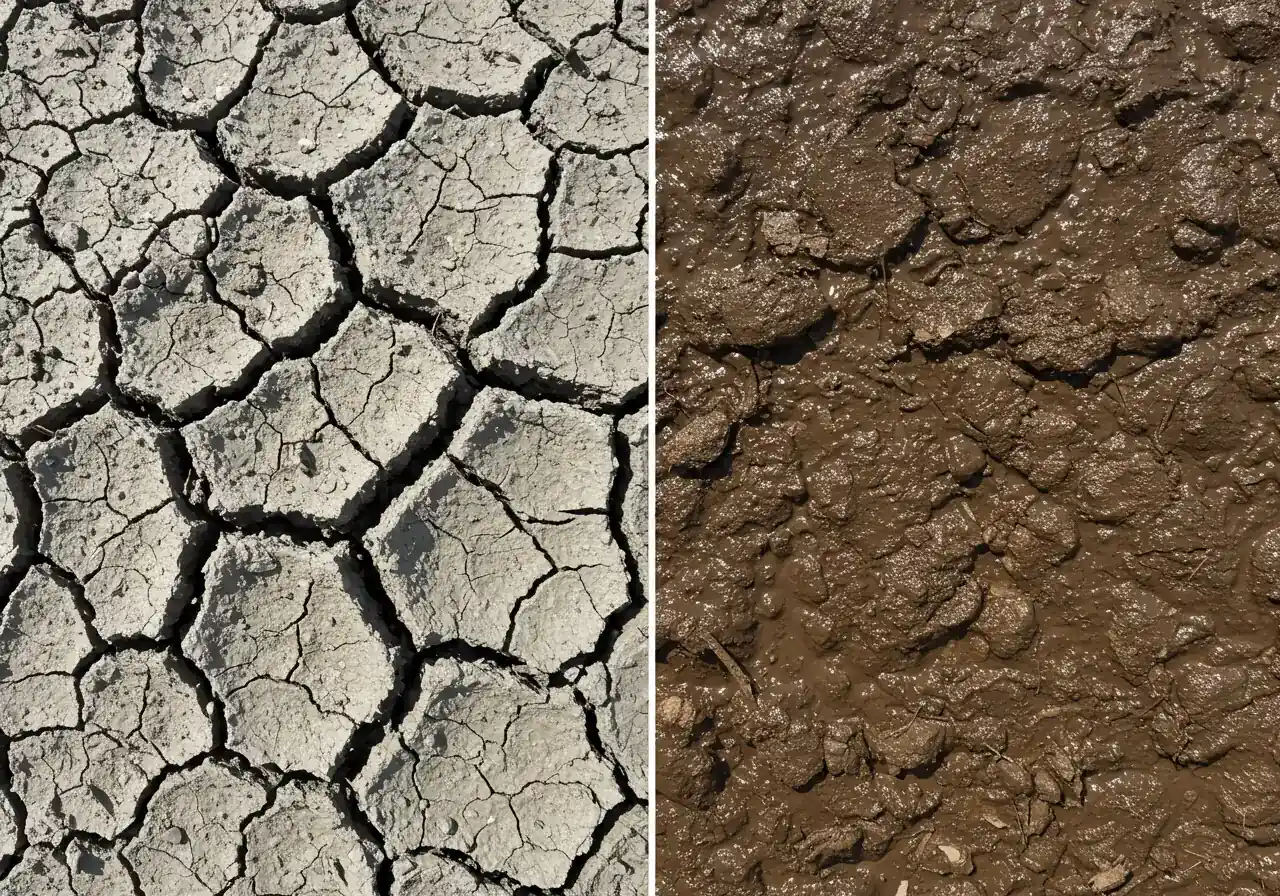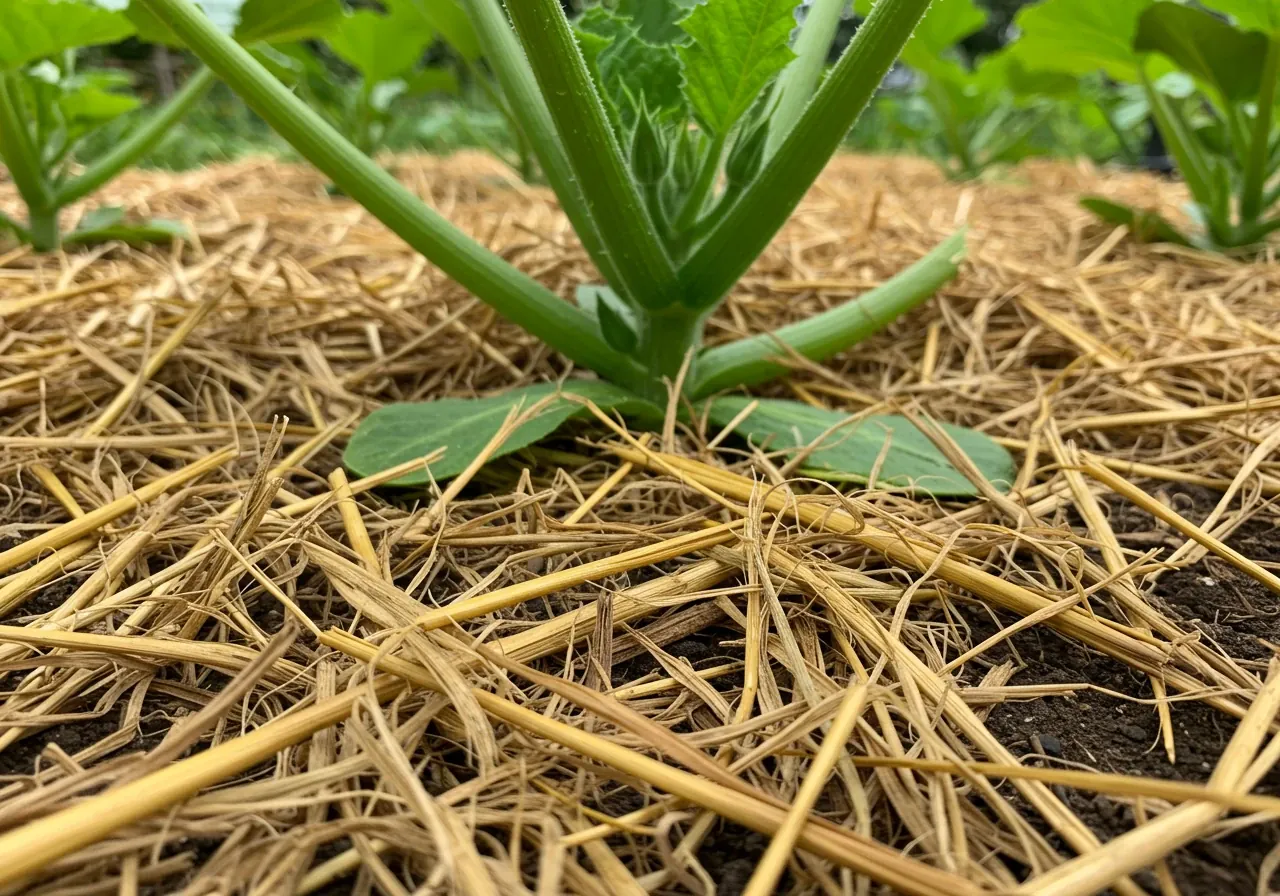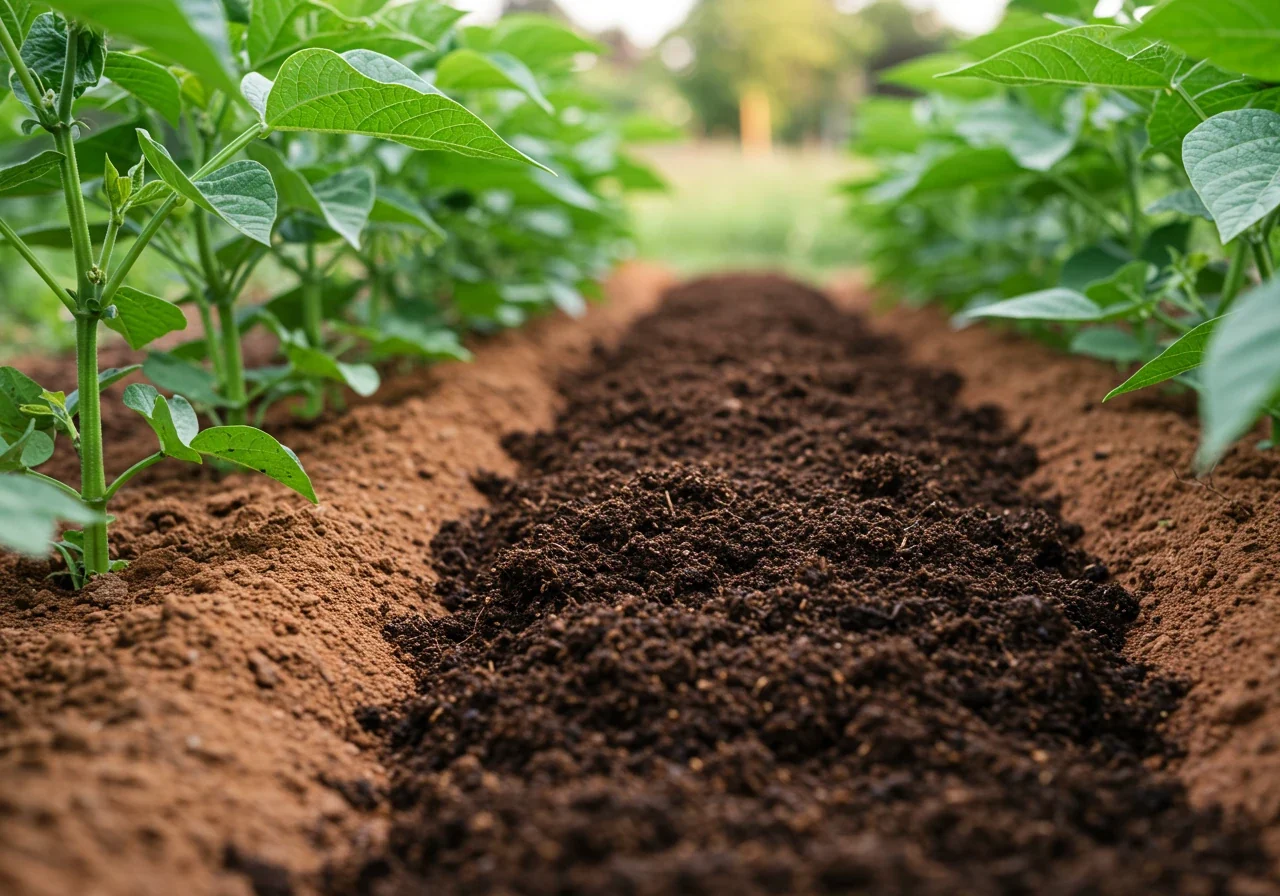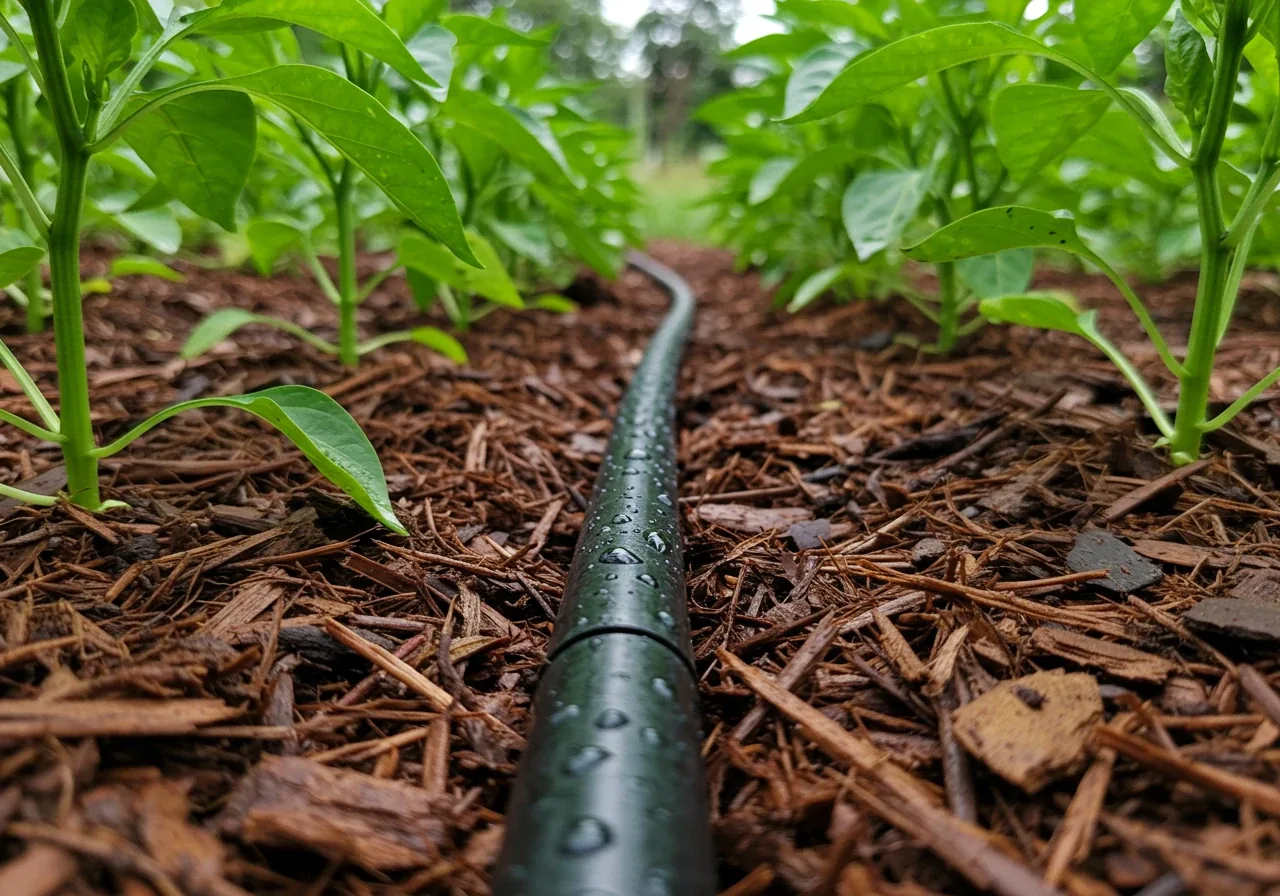Boost Russell Veggie Harvest: Summer Care on Clay Soil
Quick Guide: Thriving Veggies in Russell Clay
- Understand Clay: Holds nutrients/water well but drains slowly and compacts easily.
- Improve Structure: Consistently add organic matter (compost!)
- Water Smartly: Water deeply and infrequently, using soaker hoses if possible.
- Mulch Generously: Protects soil, retains moisture, and suppresses weeds.
- Feed Organically: Use compost and organic fertilizers for steady nutrition.
- Manage Pests Gently: Use IPM methods, starting with the least harmful.
Introduction: Russell Veggie Gardens vs. The Clay Conundrum
Hey Russell veggie gardeners! Dreaming of baskets overflowing with juicy tomatoes and crisp lettuce this summer, only to have your shovel *thud* against that infamous local clay? You're definitely not alone! Tackling heavy clay soil is a familiar story for many of us gardening right here in Russell and nearby communities like Embrun. It can often feel like you're trying to plant directly into pottery clay – it's tough to dig, slow to drain after one of those classic Ottawa downpours, and can bake brick-hard during dry spells.
We affectionately call this the "Clay Conundrum." It's that sticky, clumpy challenge standing between you and your dream garden plot. But here's the fantastic news: stubborn clay *doesn't* have to mean a disappointing harvest! With a little understanding and some smart gardening techniques, you absolutely *can* work with, and even improve, your clay soil. This section is all about providing practical tips and actionable advice to help you turn that challenging patch into fertile ground where your vegetables can truly thrive. Let's dig in (carefully!) and learn how to conquer the clay together!
Getting Friendly with Your Clay: Understanding Russell's Soil

Alright, let's roll up our sleeves and get acquainted with the star of the show (or sometimes the villain!) – that Russell clay soil. Think of it less as an enemy and more as a misunderstood friend with *lots* of personality. Understanding its quirks is the first step to a successful veggie garden right here in the City of Ottawa region.
So, what *is* clay soil, really? Imagine super, super tiny rock particles, way smaller than sand or silt. Because they're so small, they pack together *really* tightly. This tight packing is responsible for clay's famous characteristics:
- When Wet: It gets sticky and heavy, almost like dense plasticine. Water takes ages to drain through those tiny spaces. After a heavy rain, you might find puddles sitting on top for a while. This poor drainage can be tough on plant roots, which need oxygen just as much as water.
- When Dry: Remember those tightly packed particles? When the water evaporates, they cling together like glue, often baking into a hard, brick-like surface. You might even see cracks appear, especially during those dry summer spells we sometimes get. This hardness makes it difficult for roots to penetrate and for water to soak in.
It sounds a bit challenging, right? And honestly, sometimes it is! But clay isn't all bad news. Here’s the upside:
- Nutrient Powerhouse: Those tiny particles are great at holding onto essential nutrients that your veggies need to grow strong. Unlike sandy soil where nutrients wash away easily, clay hangs onto them.
- Water Retention: While slow drainage can be a problem, clay's ability to hold water means it stays moist longer during dry periods compared to other soil types. Your plants might appreciate this during a summer drought, *if* the soil structure allows roots to access that water.
The main challenge, whether you're gardening in Russell, Metcalfe, or over near Winchester, is improving that *structure*. We need to loosen things up to improve drainage and aeration, making it easier for roots to grow and access those lovely nutrients and water. Compaction is a big enemy of clay soil health, much like it is for lawns; understanding how spring aeration helps Nepean lawns breathe gives you an idea of why breaking up compaction is vital for soil life underground. Addressing the 'baked brick' issue often involves adding organic matter and using mulch effectively – you can explore related ideas in these Nepean spring mulch tips for clay soil.
Improving soil isn't just about better veggies; it's about creating a healthier, more enjoyable outdoor space overall. It's a rewarding investment, similar perhaps to how homeowners consider enhancing their yards with structures discussed in these popular Winchester pergola plans that boost home value. Ultimately, creating good soil structure through methods like adding compost and sometimes aeration (similar principles apply as highlighted in these lawn aeration soil secrets discussed for Greely) is key.
Understanding your clay is step one. Next, we'll talk about how to work *with* it! And if improving large areas of tough soil feels overwhelming, remember help is available. Check out our range of landscaping and garden services if you need a hand with the heavy lifting.
Summer Soil Spa Day: Improving Clay Structure While Veggies Grow


Okay, let's give that hardworking clay soil a little summer pampering! It's time for a "Summer Soil Spa Day," focusing on improving that tricky clay structure *while* your precious veggies are busy growing. Think of it as giving your garden bed a refreshing facial and a gentle massage – all designed to make it a happier place for plant roots.
Even with plants established, summer gives us unique opportunities to boost soil health without major disruption. While spring might be for heavy lifting, summer is about nurturing and refining. Especially in areas like Embrun or Metcalfe, where clay can go from soggy to concrete-hard seemingly overnight, these summer steps are crucial.
The Mid-Season Treat: Top-Dressing with Organic Goodness
One of the best things you can do for clay soil *any* time, but especially when plants are growing, is to top-dress with compost or well-rotted manure. This is like adding a nutrient-rich, fluffy blanket. It doesn't involve heavy digging (which can disturb roots), but slowly introduces organic matter that worms and microbes will pull down into the soil, gradually improving structure, drainage, and aeration.
Here’s your simple step-by-step guide to top-dressing:
- Gather Your Gold: Get your hands on some good quality compost. You can make your own (go you!), buy bags from a garden center, or sometimes find bulk sources near Ottawa. Quality matters more than quantity here.
- Weed First: Gently remove any weeds competing with your veggies. This ensures the compost benefits your plants, not the freeloaders. A quick tidy-up can make a big difference, and if your beds are feeling overwhelming, remember that help is available with an Ottawa garden clean up service.
- Apply Gently: Carefully spread a layer of compost, about 1-2 inches thick, around the base of your established plants. *Avoid piling it directly against the plant stems*, as this can trap moisture and potentially cause rot. Think donut, not volcano!
- Water It In: Give the area a gentle watering. This helps settle the compost and starts moving those beneficial microbes and nutrients towards the root zone.
Mulch Magic: The Protective Layer
Mulch is the superhero cape for your summer garden soil, especially clay. It protects against moisture loss during dry spells, keeps the soil temperature more even (roots hate extreme heat!), suppresses weeds, and, depending on the type, slowly breaks down to add *more* organic matter.
Choosing Your Mulch: Not all mulches are created equal for clay soil veggie gardens. Here’s a quick comparison:
| Mulch Type | Pros for Clay Soil | Cons for Clay Soil | Notes |
|---|---|---|---|
| Straw / Chopped Hay | Excellent insulation, breaks down well, adds OM* | Can contain weed seeds (use clean straw) | Great for veggie beds, light & airy. |
| Shredded Leaves | Free! Breaks down beautifully, adds lots of OM* | Can mat if applied too thickly | Collect in fall, shred with mower. Apply 2-3 inches. |
| Compost | Adds nutrients directly, improves structure | Can be expensive, may need reapplying | Can be used *as* mulch, or under another mulch. |
| Wood Chips | Long-lasting, good weed control | Can temporarily tie up nitrogen | Best for pathways or around perennial plantings, less ideal *in* annual veggie beds. Learn more about mulching and edging here. |
*OM = Organic Matter
Applying mulch effectively is a key part of garden maintenance. If you're in the Embrun area and need assistance getting your beds properly mulched, consider looking into an Embrun garden clean up service for professional help.
Gentle Aeration: Helping Your Soil Breathe (Carefully!)
While deep tilling is a no-no when plants are growing (it destroys soil structure and roots), you *can* perform some gentle aeration. If you notice water pooling badly or the ground seems extra compacted in certain spots (maybe a pathway between rows), carefully use a garden fork.
How to do it gently: Push the fork straight down into the soil about 4-6 inches deep, wiggle it *gently* back and forth (don't turn the soil over!), and pull it straight out. Do this every 6-8 inches *only where needed and well away from plant root zones*. This creates small channels for air and water without major disruption. This is especially helpful in areas like Metcalfe where foot traffic might compact paths between beds – dealing with compacted soil might even require help from a Metcalf yard cleanup service if it's widespread.
Eco-Friendly Boosts
- Water Wisely: Water deeply and less frequently to encourage deep root growth, rather than shallow, frequent watering. Mulch helps immensely here!
- Feed the Worms: Earthworms are your best friends in clay soil! Adding compost encourages them. They tunnel through the clay, improving drainage and aeration naturally. Consult resources like the OMAFRA guide on earthworms for more info.
- Avoid Compaction: Try to stick to designated paths and avoid walking on wet garden beds whenever possible.
Improving clay soil is a marathon, not a sprint. These summer spa treatments won't magically transform concrete into loam overnight, but they are vital steps in the right direction. Consistent effort, adding organic matter year after year, truly makes a difference. You can witness some amazing soil health improvements and garden productivity shifts over time – check out these inspiring garden transformations to see what's possible! And remember, if the task feels too large, exploring professional landscaping and garden services can provide the support you need to achieve your garden goals. Happy growing!
Watering Wisdom: Quenching Thirsty Roots in Stubborn Clay

Alright, let's talk hydration! Watering your veggie garden in Russell's clay soil isn't quite like watering sandy soil. Clay, bless its dense heart, holds water tightly but also absorbs it *very* slowly. Think of it less like a sponge and more like a tightly woven cloth – water takes its sweet time soaking in. This means our watering strategy needs to be smart to avoid puddles on top while the roots below stay thirsty, or worse, waterlogged.
The golden rule for watering clay soil, especially during Ottawa's sometimes scorching, sometimes soaking summers, is: Water Deeply and Infrequently.
Why? Because shallow, frequent watering (like a quick sprinkle every day) only wets the top inch or two. This encourages plant roots to stay near the surface, making them vulnerable during dry spells. Plus, a lot of that surface water just evaporates before it can do much good. We want to encourage those roots to dive deep into the soil where moisture lingers longer.
- What Deep Watering Looks Like: Instead of a 5-minute sprinkle daily, aim for a long, slow soak once or twice a week, depending on the weather. You want the water to penetrate at least 6-8 inches deep.
- How to Check: About an hour after watering, carefully dig down with a trowel (away from main roots!) and see how far the moisture has reached. Adjust your watering time accordingly.
Contrast with Poor Practices: Giving plants tiny sips daily leads to weak, shallow roots. It wastes water through evaporation and runoff, especially on sloped areas. It can even contribute to soil compaction over time and might necessitate more significant interventions later, perhaps even needing an Ottawa property cleanup service to deal with resulting erosion or drainage issues in the wider yard. Managing water correctly often prevents bigger headaches.
Smart Watering Methods for Clay:
- Soaker Hoses & Drip Irrigation: These are your best friends! They deliver water slowly, right at the soil level, directly to the root zone. This minimizes evaporation and allows the clay time to absorb the moisture without creating runoff. It's a set-it-and-forget-it approach (almost!) that works wonders. Proper watering is fundamental to achieving those lush results you see in inspiring garden transformations.
- Hand Watering (with Patience): If using a hose or watering can, water slowly around the base of each plant. You might need to make a couple of passes, letting the water soak in between, to get the depth needed without it all running off.
Timing is Everything:
The best time to water is early morning. This gives the water plenty of time to soak deep into the soil before the heat of the day kicks in and maximizes evaporation. It also allows plant leaves to dry off before evening, reducing the risk of fungal diseases that love damp nighttime conditions. Watering midday is inefficient, and evening watering can invite pests and diseases.
Listen to Your Plants and Soil:
Don't just water on a rigid schedule. Check the soil first! Stick your finger down a few inches. If it feels dry, it's time to water. If it's still moist, hold off. Plants will also give clues – slight wilting *early* in the day (not just in the afternoon heat) can signal thirst. Conditions can vary even within the Ottawa area; a garden bed in sunny Manotick might dry out faster than one with more shade. Pay attention to *your* specific garden. Good watering habits support healthy plants, which are less work in the long run – unlike dealing with widespread weed issues that might need a city yard cleanup service. Keeping plants healthy through proper watering is much easier than a major cleanup! For instance, well-watered soil is less prone to becoming overly compacted and weedy, problems that sometimes necessitate a call to the Metcalf garden clean up service for remediation. Remember that lawn watering needs differ too; while veggie gardens need deep soaks, establishing new grass requires different techniques, something to keep in mind if you're considering professional sod installation.
So, remember: deep, infrequent soaks, ideally with slow delivery methods like soaker hoses, early in the morning. Your clay soil and thirsty veggie roots will thank you!
Clay Soil vs. Loam: A Quick Comparison
Clay Soil Characteristics
- Texture: Fine particles, sticky when wet, hard when dry.
- Drainage: Very slow. Prone to waterlogging.
- Aeration: Poor. Can become compacted easily.
- Nutrient Retention: Excellent. Holds onto nutrients well.
- Water Retention: High. Stays moist longer but absorbs slowly.
- Workability: Difficult, especially when very wet or very dry.
Think: Dense, holds potential but needs structural help.
Ideal Loam Soil Characteristics
- Texture: Balanced mix of sand, silt, and clay. Crumbly feel.
- Drainage: Good. Allows excess water to pass through.
- Aeration: Excellent. Plenty of air spaces for roots.
- Nutrient Retention: Good. Holds nutrients adequately.
- Water Retention: Good. Holds enough moisture without being soggy.
- Workability: Easy to dig and cultivate in various conditions.
Think: The "just right" Goldilocks soil for most plants.
Bridging the Gap: Improving Clay
The goal isn't necessarily to turn clay *into* loam overnight, but to improve its structure and behaviour using loam-like principles:
- Add Organic Matter: Compost, compost, compost! This is the #1 way to improve structure, drainage, and aeration over time. Explore our property clean up services if you need help clearing space for composting or new beds.
- Mulch Heavily: Mimics the protective layer found in healthy ecosystems, moderating temperature and moisture.
- Avoid Compaction: Treat your soil gently. Use pathways and avoid walking on wet beds.
- Consider Raised Beds: A faster way to create an ideal growing environment above the challenging native soil for your new garden installations.
- Water Appropriately: Adapt watering to clay's slow absorption rate (deep and infrequent).
Feeding the Feast: Summer Nutrient Needs on Clay Soil
Okay, let's dish about dinner time for your veggies! While we know Russell's clay soil can be a nutrient powerhouse, holding onto goodies like a squirrel with its prize acorn, sometimes those nutrients aren't easily available to plant roots. Think of it like having a fully stocked pantry, but the cans are all tricky to open! Especially during the demanding summer growing season, our vegetable plants need a reliable source of food to produce that delicious harvest we dream about in places like Nepean or Barrhaven.
Clay's density can sometimes "lock up" nutrients, making them chemically unavailable to plants. Plus, the slow drainage we discussed earlier can impact nutrient uptake. So, how do we ensure our summer feast is well-fed?
Go Organic: The Slow and Steady Meal Plan
Forget those harsh chemical fertilizers that give a quick jolt but do little for long-term soil health. Organic fertilizers are the way to go on clay soil. They release nutrients slowly and gently, feeding your plants over time *and* feeding the beneficial soil microbes that help improve soil structure. It's a win-win!
- Compost is King (Again!): We mentioned top-dressing earlier, and it bears repeating. Regular additions of compost provide a balanced diet and improve the soil's ability to make existing nutrients available. Choosing the right compost is key; our guide on thoughtful material selection can offer insights into picking quality amendments.
- Compost Tea Time: Brew up some "compost tea" by steeping finished compost in water (aerating it helps!). Use this liquid gold as a foliar spray or soil drench every few weeks for a gentle nutrient boost.
- Side-Dressing: For heavy feeders like tomatoes, corn, or squash, you can "side-dress" mid-season. Gently scratch a little well-rotted manure or a balanced organic granular fertilizer into the soil surface around the plant (a few inches away from the stem), and water it in. Keeping the area free of weeds ensures your plants get the food, not the invaders; sometimes a thorough weeding is needed, similar to the work done by a Marionville garden clean up service to prep beds properly.
Know Your Guests: Tailoring the Menu
Not all veggies have the same appetite:
- Heavy Feeders: Tomatoes, peppers, eggplant, corn, squash, cucumbers, broccoli, cabbage. These guys appreciate a mid-season boost.
- Light Feeders: Beans, peas, lettuce, spinach, radishes, carrots, beets. Often, the nutrients from initial soil prep and compost are enough. Over-fertilizing leafy greens can lead to lush leaves but poor root development (for carrots/beets) or delayed fruiting.
Reading the Signs: Is Anyone Still Hungry?
Your plants will often tell you if they're lacking something:
- Yellowing Lower Leaves (Nitrogen deficiency): Often the first sign. Needs a nitrogen boost, often supplied by compost or balanced organic fertilizer.
- Purple Tinges (Phosphorus deficiency): Can happen in cool soil, but persistent purpling might need attention. Bone meal or rock phosphate can help (use sparingly).
- Yellowing Between Leaf Veins (Magnesium/Iron deficiency): Sometimes occurs in clay. An Epsom salt solution (magnesium) or chelated iron might help, but address soil health first.
Simple Summer Feeding Guideline (Approximate):
Planting Time
Amend soil well with compost. This provides the initial feast. A clean bed makes this easier – if yours is overgrown, an Ottawa yard cleanup service can help reset the stage.
4-6 Weeks After Planting (Heavy Feeders)
Side-dress with compost or a balanced organic fertilizer. Or start applying compost tea every 2-3 weeks. Remember to follow application rates carefully – just like reading the terms and conditions before agreeing to something, always read the fertilizer label!
Mid-Summer (Heavy Feeders, Fruiting)
Another light side-dressing or compost tea application can support fruit production. Maintaining a tidy garden through summer helps nutrient uptake; if things get out of hand, remember professional help like a Metcalf garden clean up service is available.
Light Feeders
Generally, just monitor their health. Compost tea is usually safe if you feel they need a little pick-me-up. Ongoing garden maintenance can include this monitoring.
Remember, feeding your soil with organic matter is the *best* long-term strategy for feeding your plants in Ottawa's clay. Happy feasting!
Estimated Impact of Organic Matter on Clay Soil Properties (Illustrative)
Note: Values are illustrative percentages representing improvement potential.
Troubleshooting Toolkit: Tackling Summer Pests & Problems on Clay
Okay, team, even with the best soil prep and watering habits, summer gardening in Ottawa – especially on our famous clay soil – can sometimes feel like playing whack-a-mole with problems. Between sudden downpours turning paths slick, surprise heatwaves baking the ground, and uninvited guests munching on our hard work, it helps to have a troubleshooting toolkit ready! Don't worry, we've got your back with ways to tackle common summer hurdles.
Problem: Soggy Bottoms & Baked Tops
Clay's slow drainage means heavy summer rain can lead to waterlogged roots, while intense sun can bake the surface brick-hard, stressing plants. Compaction from foot traffic (even our own!) makes both issues worse.
Solution: Prevention is key here. Ensuring good initial soil preparation with plenty of organic matter is your first line of defense. During summer, *strictly* avoid walking on wet soil. Maintain that lovely layer of organic mulch (straw, shredded leaves) discussed earlier – it buffers against both heavy rain impact and surface baking. If compaction is already an issue in pathways, gentle aeration with a garden fork (when dry!) can help, but avoid disturbing plant roots.
Problem: Uninvited Dinner Guests (Pests!)
Summer brings out the bugs. While many are beneficial, a few can cause headaches for veggie gardeners from Richmond to Kars. We favour Integrated Pest Management (IPM) – using the least harmful methods first. Resources like Health Canada's Pest Management section offer guidance.
- Pesky Aphids: These tiny sap-suckers cluster on new growth.
Solution: Often, a strong blast of water from the hose knocks them off. If they persist, try insecticidal soap (follow label directions!). Encourage ladybugs – they love aphids! A clean garden offers fewer hiding spots for pests; if things get overwhelming, a Marionville yard cleanup service can help reset the balance. - Squash Vine Borer: The bane of zucchini and pumpkin growers! Moths lay eggs at the base, larvae tunnel in, and the plant wilts suddenly.
Solution: Cover young plants with floating row covers until they start flowering (then remove for pollination). Wrap the base of stems loosely with foil. If you see sawdust-like frass (bug poop!) near the base, you can *carefully* slit the vine lengthwise with a clean knife, remove the grub, and bury the wounded vine section in moist soil – it might re-root. Choosing resistant varieties during your thoughtful material selection phase can also help.
Problem: Heat Stress Wilting
During those Ottawa heatwaves, even well-watered plants can look droopy, especially in heat-absorbing clay.
Solution: Mulch, mulch, mulch! It keeps soil cooler and retains moisture. Ensure deep, consistent watering (early mornings!). Provide afternoon shade for sensitive plants using taller companions or temporary shade cloth. Sometimes, plants wilt in extreme heat as a defense and perk up in the evening – check the soil moisture before assuming they need more water. Regular observation is crucial; ongoing support from a city garden maintenance service often includes monitoring for and mitigating stress factors like these.
Gardening on clay has its moments, but watching your plants thrive makes it worthwhile. Keep observing, be patient, and don't be afraid to adjust your strategies. We hope these tips help you navigate the summer season smoothly, and offer a big thank you for visiting our site and learning alongside us!
Need more local advice? Check out the Ottawa Horticultural Society for events and resources.
Clay Soil Quick Wins: Summer Veggie Boosters
Summer is in full swing here in the Ottawa area, and your vegetable garden is working hard! But let's be honest, coaxing peak performance out of our notorious clay soil, whether you're in Manotick or Metcalfe, can sometimes feel like convincing a cat to enjoy a bath. It requires patience! While long-term soil improvement is the ultimate goal, sometimes you just need a few quick wins – easy boosts you can give your veggies *right now* to help them thrive through the heat and humidity.
Think of these as little pick-me-ups for your plants and soil, no major landscaping overhauls required. Let's jump into some simple summer boosters!
1. The Instant Compost Top-Up
Remember how we talked about organic matter being clay soil's best friend? Well, even a quick top-dressing *right now* makes a difference. Grab a bag or wheelbarrow of finished compost (that lovely dark, crumbly stuff) and gently spread about an inch around the base of your veggie plants. Don't dig it in – just lay it on top.
Why it's a quick win:
- Moisture Magnet: It acts like a mini-mulch, helping retain water near the roots.
- Microbe Meal: It feeds the beneficial soil life that’s slowly improving your soil structure.
- Nutrient Nibble: It provides a slow-release snack for your plants.
Your plants (and the hardworking earthworms tunneling below) will surely give you a big thank you for this simple treat!
2. Refresh That Mulch Magic
Is your mulch looking a bit thin? Has it broken down or blown away? Applying or replenishing mulch is one of the *fastest* ways to make your veggies happier campers during summer. A 2-3 inch layer of straw, shredded leaves, or even untreated grass clippings (applied thinly so they don't mat) works wonders.
Why it's a quick win:
- Cool Roots: Mulch insulates the soil, keeping roots cooler during hot afternoons – clay soil can really bake!
- Water Saver: It drastically reduces evaporation, meaning your watering efforts go further.
- Weed Warrior: It smothers many competing weeds, giving your veggies all the resources.
Keeping beds tidy and well-mulched is easier than dealing with a jungle later. If your whole garden space feels overwhelming, remember that a city garden clean up service can help whip things back into shape.
3. Fine-Tune Your Watering Habits TODAY
Are you still giving your garden quick, shallow sprinkles? Make the switch *today* to deep, less frequent watering. Clay absorbs water slowly, so a long, slow soak allows moisture to penetrate deeply, encouraging stronger, more resilient roots.
Why it's a quick win:
- Drought Defense: Deeper roots can access moisture even when the surface dries out.
- Reduced Runoff: Slow watering minimizes water waste, especially on slight slopes.
- Healthier Plants: Consistent moisture availability reduces plant stress.
Check the soil moisture a few inches down before watering. If it's damp, wait another day! Proper water management is key not just for beds but for the whole property; major drainage issues sometimes require more extensive solutions, like those offered by a Metcalf property cleanup service that handles broader yard concerns.
4. Brew Up a Quick Liquid Boost
Are some plants looking a bit pale or sluggish despite your best efforts? A quick liquid feed can provide readily available nutrients for an immediate pick-me-up. Compost tea (steeped compost) or a diluted organic liquid fertilizer (like fish emulsion or kelp meal) applied according to package directions can give plants, especially heavy feeders like tomatoes or zucchini, a helpful nudge.
Why it's a quick win:
- Fast Absorption: Liquid nutrients are easily taken up by plant roots (or leaves if used as a foliar spray).
- Targeted Help: You can give extra support specifically to plants that seem to need it most.
- Gentle Nutrition: Organic options feed the soil biology too.
Pay attention to your plants' signals. Careful observation is key in gardening, helping you spot needs or issues early – much like paying attention to details is important when reviewing documents, such as understanding how websites handle data as outlined in their privacy policy.
5. Win the Weed War (Small Skirmishes Count!)
Weeds compete directly with your veggies for water, nutrients, and sunlight. Spending even 10-15 minutes *today* pulling weeds around your plants makes an immediate difference by freeing up those resources for your intended crops. Get them while they're small!
Why it's a quick win:
- More Resources for Veggies: Less competition means more food and water for your plants *right now*.
- Better Airflow: Removing dense weeds improves air circulation, reducing disease risk.
- Prevents Seeds: Stops weeds from going to seed and creating bigger problems later.
Consistent weeding prevents small issues from becoming overwhelming infestations that might need a more intensive approach, like the services offered by a Marionville property cleanup service for seriously overgrown areas.
Clay Soil Summer Boosters: Quick Tips
Need a fast reminder? Here are key summer actions for happy veggies in clay:
- Top-Dress with Compost: Add a 1-inch layer around plants now for food and moisture.
- Mulch Your Beds Well: Apply 2-3 inches of straw or shredded leaves to keep roots cool and moist.
- Water Deeply, Not Daily: Soak soil thoroughly 6-8 inches deep, less often, preferably in the morning.
- Offer a Liquid Snack: Use compost tea or organic liquid fertilizer for a quick boost if plants look hungry.
- Pull Weeds Promptly: Remove competitors regularly so your veggies get all the goodies.
These quick wins won't magically transform your clay into perfect loam overnight, but they *will* give your summer vegetables a noticeable boost. Keep up the great work, and enjoy the delicious results of your gardening efforts! Don't forget to provide feedback on estimates if you use our services.
Your Russell Clay Soil Questions Answered (FAQs)
Absolutely, yes! It takes a bit more effort initially than gardening in perfect loam, but clay soil holds nutrients and water well. The trick is improving its structure over time with lots of organic matter like compost. With consistent effort, you can turn that challenging patch into a productive veggie haven. Plenty of fantastic gardens thrive right here in the Ottawa area on clay!
Add organic matter! Compost is your champion. Top-dressing with an inch or two of finished compost now, and digging more in during spring and fall, works wonders. It feeds soil life, improves drainage, and makes clay easier to work. Avoid tilling when wet, and keep adding that good stuff – it’s the key to long-term success.
Oh boy, please don't do that! It sounds logical, but adding sand to heavy clay usually creates something closer to concrete or homemade bricks – yikes! You need a *huge* amount of sand to make a difference, and it’s easy to get the ratio wrong. Stick with adding *organic matter* like compost and aged manure; it’s much safer and more effective.
Improving drainage is key. Raised beds can lift roots above the soggiest zone. Also, consistently adding compost helps create better soil structure, allowing water to penetrate more easily over time. Ensure mulch isn't packed too tightly, and avoid compacting the soil by walking on it when wet. For persistent issues across a larger area, sometimes broader solutions explored by a city property cleanup service might be needed to address overall yard drainage.
Mulch is your superhero! A 2-3 inch layer of organic mulch (like straw or shredded leaves) keeps the soil cooler and dramatically reduces evaporation, holding moisture near the roots. Water deeply and less frequently to encourage deep roots. Consistent watering schedules are part of good upkeep, something covered in reliable garden maintenance routines.
Yes! Consider no-dig or lasagna gardening methods – layering organic materials right on top of the existing ground. Raised beds also minimize the amount of clay you need to wrestle with directly. If starting a new bed feels overwhelming due to compacted soil or weeds, getting help from a service like a Marionville property cleanup service can give you a clean slate. You can learn more about us and our approach to making landscaping easier. Visit our Google Business Profile for reviews!
Conclusion: Harvesting Success from Your Russell Clay Patch
Well, fellow Russell green thumbs, we've dug deep into the world of clay soil gardening! Remember when that patch felt more like a pottery project than a veggie plot? Hopefully, now you see it less as a challenge and more as *workable* ground brimming with potential. The secret sauce really boils down to a few key ingredients: consistently adding *organic matter* (hello, compost!), watering wisely (deep soaks, not daily sprinkles), using mulch like it's going out of style, and having a healthy dose of patience. Clay rewards consistency!
Turning that stubborn soil into a thriving vegetable garden *is* achievable, leading to those delicious, home-grown harvests we all crave right here in the Ottawa region. You absolutely can harvest success from your patch. But hey, we get it – sometimes life gets busy, or the task just feels too big for one pair of hands.
Ready to boost your soil without breaking your back? If you need help getting started with amending your soil, building productive raised garden beds, or getting that essential mulch layer down perfectly, we're here for you! We offer professional landscaping and garden services throughout Russell, Vernon, Kenmore, Winchester, and the wider Ottawa area.
Need ongoing support or planning a bigger garden transformation? Let us handle the heavy lifting and expert care! Contact Clean Yards Ottawa today for reliable garden maintenance and landscaping solutions tailored to your needs. Give us a call at 613-701-4646 or visit us online at cleanyards.ca to discuss your project. Happy harvesting!

